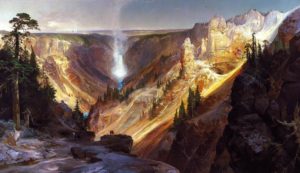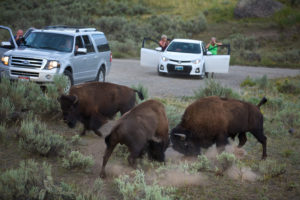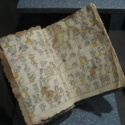I’ve finally finished my PhD work, and I can rededicate myself to blogging (more) regularly and taking ScratchTap in new directions. This fall, I’ll be presenting a paper on documents and moral knowledge at the Annual Meeting of the Document Academy. Here’s a snippet of what I’m thinking about.
Documents have traditionally been conceptualized as representations of reality. As such, we know a lot about how they show and afford facts about the world. Recently, scholars have been exploring how documents can also construct reality. With this view, we can begin to think about how documents show and afford moral knowledge, or knowledge about what people ought to value in the world and how people ought to act. In this realm, much of the discussion centers around texts, such as works of fiction. Reading Crime and Punishment, for example, is a great way to build your moral imagination.
But what about visual art? I’d like to consider two works of art depicting Yellowstone National Park, one from the 19th century and another from the 21st. By analyzing these works as documents, we can see how art played and continues to play a decisive role in how Americans conceptualize and value the wilderness—perhaps even more than scientific documents.
 The first document is a painting done in 1871 by Thomas Moran depicting the Grand Canyon of the Yellowstone. The work was done while Moran was a guest artist on a geographic survey. Moran’s work showed the beauty and scale of the Yellowstone region more effectively than other descriptions, such that Moran’s work was decisive in the United States passing the National Parks Act in 1872, forming Yellowstone National Park and setting the stage for other regions in the United States—and other countries—to be preserved as national parks.
The first document is a painting done in 1871 by Thomas Moran depicting the Grand Canyon of the Yellowstone. The work was done while Moran was a guest artist on a geographic survey. Moran’s work showed the beauty and scale of the Yellowstone region more effectively than other descriptions, such that Moran’s work was decisive in the United States passing the National Parks Act in 1872, forming Yellowstone National Park and setting the stage for other regions in the United States—and other countries—to be preserved as national parks.

The second document is a 2014 photograph by Michael Nichols, depicting three bison at Yellowstone National Park being photographed by a group of people near their automobiles. Nichols’ work was part of a National Geographic project documenting Yellowstone National Park which sought to expose the tension between the park’s existence as a wildlife preserve and a site for human enjoyment.
Both of these works respond to a dualism in the human relationship to the wilderness, dating back at least to the European colonization of America. On one hand, (1) we see the wilderness as a store of commodities to be profited from; and on the other, (2) we see the wilderness as a dangerous, chaotic blur that defies comprehension. Thus the U.S. National Parks are at once “for the benefit and enjoyment of the people,” and also a preserve of nature and wildlife for its own sake.
In their artworks, both Moran and Nichols seem to reject (1), but they do so in different ways: Moran does so by depicting (2), while Nichols does so by holding up a mirror to (1).
If we think of the purpose of these documents as providing moral knowledge, we can ask which approach is more effective. Moran’s work had the almost immediate effect of the creation of the U.S. National Parks. Nichols’ work cannot yet boast any such effects. Of course, many other factors complicate this picture: today’s media climate, the saturation of images, the nature of internet communication…
Still, the question should give us pause. The wilderness is disappearing, if it has not already gone. Indeed, the world itself is in grave danger, as climate change unfurls. In discourse around these topics, we have tended to appeal to scientific documents. But if artistic documents can provision the sort of moral knowledge necessary to heal our relationship to the world, then perhaps we can also appeal to art. If that is the case, then it is worth thinking about what sort of art will serve best.
 Follow
Follow
